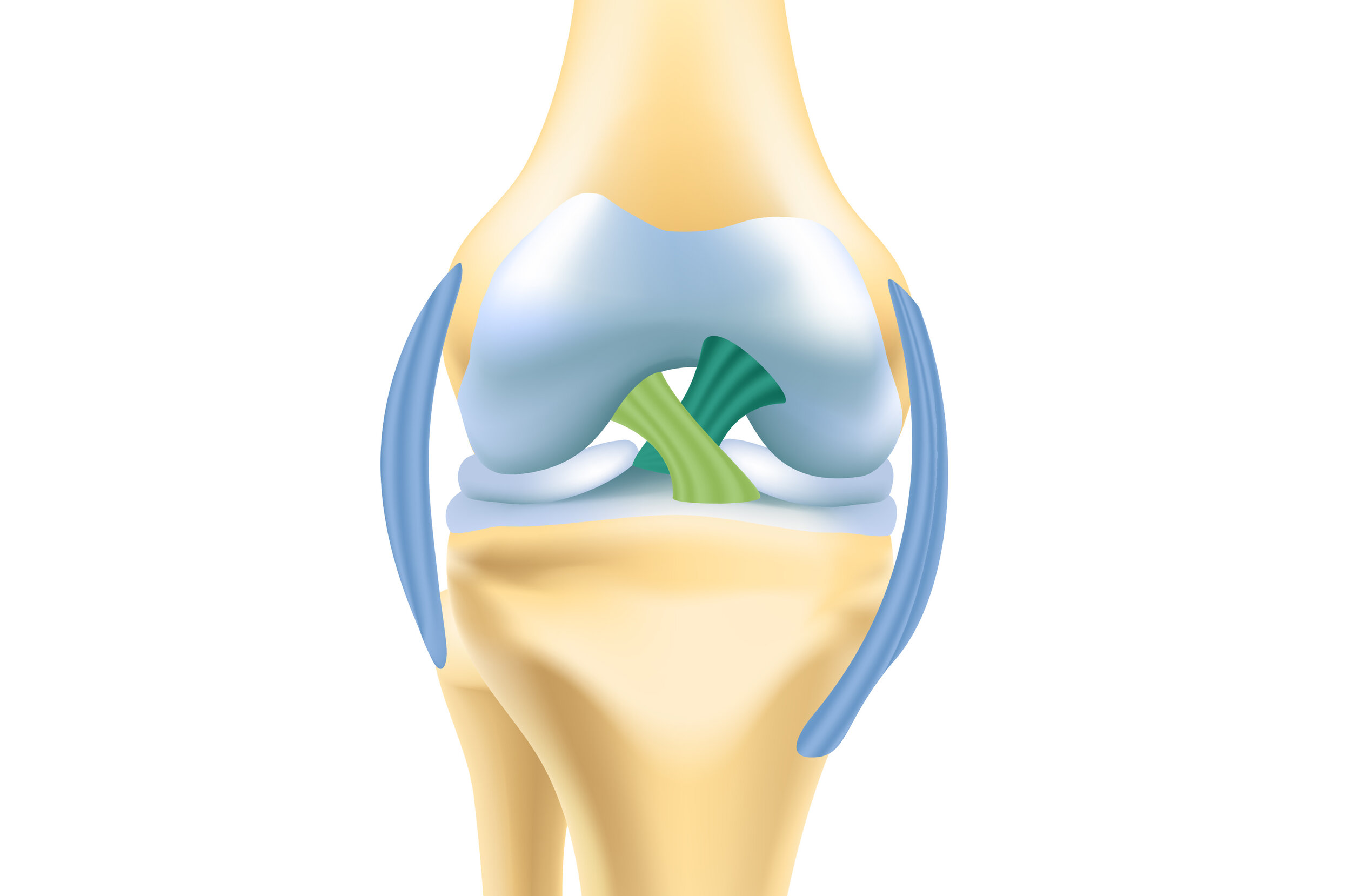Exploring the Crucial Ligaments of the Knee: Anatomy and Function
The human knee is a remarkable joint that facilitates essential movements, such as walking, running, and jumping. Within this intricate joint lie the ligaments of the knee, which play a pivotal role in maintaining stability and enabling these movements. In this comprehensive guide, we delve into the world of knee ligaments, shedding light on their anatomy, functions, and common injuries.

ligaments of the knee
Understanding Knee Anatomy
To grasp the significance of knee ligaments, it’s essential to first understand the complex anatomy of the knee joint. The knee joint is comprised of three major bones: the femur (thigh bone), the tibia (shin bone), and the patella (kneecap). These bones are interconnected by a network of ligaments and tendons, creating a system that allows for both stability and mobility.
Common Knee Ligament Injuries
Knee ligament injuries are unfortunately quite common, and they can range from mild sprains to severe tears. It’s essential to be aware of these injuries and their causes:
ACL Tears (Anterior Cruciate Ligament Tears)
Causes:
ACL tears often occur during sports activities that involve sudden stops, changes in direction, or direct blows to the knee. They are also more prevalent among athletes.
Symptoms:
Common symptoms include a popping sound at the time of injury, immediate swelling, pain, and instability in the knee. Difficulty in bearing weight and limited range of motion are also typical signs.
PCL Injuries (Posterior Cruciate Ligament Injuries)
Causes:
PCL injuries usually result from a direct blow to the front of the knee, such as in car accidents or sports-related collisions.
Symptoms:
Symptoms include swelling, pain at the back of the knee, and instability. PCL injuries can be challenging to diagnose as they often present with fewer immediate symptoms than ACL tears.
MCL Sprains (Medial Collateral Ligament Sprains)
Causes:
MCL sprains typically occur due to a force that pushes the knee sideways. This can happen in sports or due to sudden twisting motions.
Symptoms:
Patients with MCL sprains may experience pain, swelling, and instability on the inner side of the knee. Walking may be uncomfortable.
LCL Injuries (Lateral Collateral Ligament Injuries)
Causes:
LCL injuries are less common and usually result from direct blows to the outer knee or excessive stress on the inner knee.
Symptoms:
LCL injuries can cause pain, swelling, and instability on the outer side of the knee. These injuries may also affect range of motion.
Symptoms of Knee Ligament Injuries
Recognizing the symptoms of knee ligament injuries is crucial for prompt diagnosis and treatment. Here, we’ll delve into the specific signs associated with each type of injury:
ACL Tear Symptoms
Pain:
A sharp or intense pain in the knee, often accompanied by a popping sensation at the time of injury.
Swelling:
Immediate swelling of the knee joint.
Instability:
A feeling of the knee giving way or being unstable, particularly during activities.
Limited Range of Motion:
Difficulty fully bending or straightening the knee.
PCL Injury Symptoms
Pain:
Pain at the back of the knee, often less severe than ACL tears.
Swelling:
Swelling may develop over time.
Instability:
Similar to ACL injuries, patients may experience instability.
Difficulty Walking:
Difficulty bearing weight on the affected leg.
MCL Sprain Symptoms
Pain:
Pain and tenderness on the inner side of the knee.
Swelling:
Swelling in the affected area.
Instability:
The knee may feel wobbly or unstable.
Pain While Walking:
Pain may increase with walking or bearing weight on the injured leg.
LCL Injury Symptoms
Pain:
Pain on the outer side of the knee.
Swelling:
Swelling in the lateral knee area.
Instability:
Instability and weakness may be experienced.
Limited Movement:
Limited range of motion, especially when trying to bend the knee.
Understanding these symptoms can help individuals recognize when they should seek medical attention. Early diagnosis and treatment can significantly impact the recovery process.
Diagnosis and Treatment
Timely and accurate diagnosis is vital for effective treatment of knee ligament injuries. This section explores how healthcare professionals diagnose these injuries and the various treatment options available:
Diagnosis of Knee Ligament Injuries
Physical Examination:
Healthcare providers will assess the knee’s range of motion, stability, and tenderness.
Imaging Tests:
X-rays, MRI scans, or ultrasound may be used to visualize the extent of the injury.
Arthroscopy:
In some cases, a minimally invasive procedure called arthroscopy is used for a direct view of the knee’s interior.
Treatment Options
Rest and Physical Therapy:
Mild injuries may heal with rest and physical therapy to strengthen the knee.
Bracing:
Supportive knee braces may be prescribed to stabilize the joint during recovery.
Surgery:
Severe injuries often require surgical intervention, such as ACL or PCL reconstruction.
Rehabilitation:
Rehabilitation exercises are crucial for restoring strength and mobility post-surgery or in more severe cases.
Prevention of Knee Ligament Injuries
Proper Conditioning:
Maintaining strong leg muscles and overall fitness can reduce the risk of injury.
Warm-up and Stretching:
Adequate warm-up and stretching routines before physical activity help prepare the muscles and ligaments.
Proper Footwear:
Wearing appropriate footwear for specific activities can enhance stability and support.
Technique and Form:
Practicing proper techniques in sports and exercise is essential to prevent injuries.
Safety Gear:
Use protective gear like knee braces or pads, especially in contact sports.
Rehabilitation and Recovery
Physical Therapy:
A structured physical therapy program can aid in regaining strength and range of motion.
Home Exercises:
Patients are often prescribed home exercises to continue their recovery.
Follow Medical Advice:
Strictly following the recommendations of healthcare professionals is crucial for successful rehabilitation.
Gradual Return to Activity:
Patients should gradually ease back into physical activities to avoid reinjury.
By understanding prevention strategies and the importance of rehabilitation, individuals can take proactive steps to protect their knee ligaments and ensure a smoother recovery if an injury does occur.
NLP Integration
Addressing User Queries:
Providing answers to common user queries such as “How to prevent ACL tears” and “Recovery time after ACL surgery” enhances user experience and SEO.
Conversational Content:
Using natural language throughout the article creates a reader-friendly tone and increases relevance.
Expert Insights and Testimonials
Orthopedic Expert Opinions:
Including quotes and insights from orthopedic experts lends credibility to the article.
Patient Testimonials:
Real-life experiences and success stories can resonate with readers facing similar challenges.
Latest Advancements and Research
Incorporate Recent Discoveries:
Discuss the latest advancements in knee ligament injury research and treatments.
Cite Credible Sources:
Reference scientific studies and credible sources to support the information presented.
Q1: What are knee ligaments?
A1: Knee ligaments are tough, fibrous bands that connect the bones in the knee joint, providing stability and support.
Q2: What are the major knee ligaments?
A2: The major knee ligaments are the ACL (anterior cruciate ligament), PCL (posterior cruciate ligament), MCL (medial collateral ligament), and LCL (lateral collateral ligament).
Q3: How do ACL tears occur?
A3: ACL tears often happen during sports activities that involve sudden stops, changes in direction, or direct blows to the knee.
Q4: What are the symptoms of an MCL sprain?
A4: Symptoms of an MCL sprain include pain and tenderness on the inner side of the knee, swelling, and instability.
Q5: Can knee ligament injuries heal on their own?
A5: Mild injuries may heal with rest and physical therapy, but severe tears often require surgery for proper healing.
Q6: How long is the recovery period after ACL surgery?
A6: Recovery after ACL surgery can vary but typically takes several months, with physical therapy playing a crucial role.
Q7: Are knee ligament injuries preventable?
A7: Yes, knee ligament injuries can often be prevented by maintaining proper conditioning, warming up, using proper techniques, and wearing appropriate footwear.
Q8: What is the role of physical therapy in knee ligament injury recovery?
A8: Physical therapy helps restore strength, flexibility, and range of motion in the knee, aiding in recovery and preventing reinjury.
Q9: Can knee ligament injuries lead to long-term complications?
A9: Untreated or improperly treated knee ligament injuries can lead to long-term issues like chronic instability and osteoarthritis.
Q10: Are there any advancements in knee ligament injury treatments?
A10: Yes, ongoing research has led to advancements in surgical techniques and rehabilitation strategies for knee ligament injuries.
Conclusion
In this extensive exploration of knee ligaments, we’ve uncovered the crucial role these connective tissues play in maintaining knee joint stability and function. Understanding the anatomy, common injuries, and symptoms associated with knee ligaments empowers individuals to take proactive steps towards protecting their knee health.




